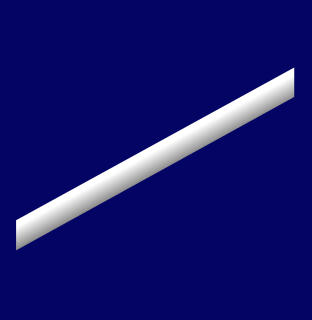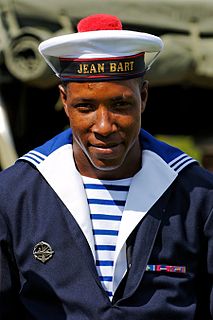
Seaman recruit (SR) is the lowest enlisted rate in the United States Navy, U.S. Coast Guard, and the U.S. Naval Sea Cadet Corps just below seaman apprentice; this rank was formerly known as seaman third class. Two separate pay grades exist within this rank — one for those with service of less than four months, with a higher pay scale for those in service for more than four months, even if they have not yet advanced to seaman apprentice.
A Petty Officer (PO) is a non-commissioned officer in many navies and is given the NATO rank denotion OR-5 or OR-6. In many nations, they are typically equal to a sergeant in comparison to other military branches. Often they may be superior to a seaman, generally they are lower ranks in a navy, and subordinate to a more senior non-commissioned officer, such as a Chief Petty Officer.

Seaman is a military rank used in many navies around the world. It is considered a junior enlisted rank and, depending on the navy, it may be a single rank on its own or a name shared by several similarly-junior ranks.

Petty officer second class is the fifth enlisted rank in the U.S. Navy and the U.S. Coast Guard, just above petty officer third class and below petty officer first class, and is a non-commissioned officer. It is equivalent to the rank of sergeant in the Army and Marine Corps, and staff sergeant in the Air Force.

The Fleet Marine Force Ribbon, officially the Navy Fleet Marine Force Service Ribbon, was a military award of the United States Navy established in 1984 by Secretary of the Navy, John F. Lehman, Jr. The service ribbon was awarded to eligible Navy personnel serving with the Marine Corps between 1984 and 2006. The award signified the acquisition of specific professional skills, knowledge and military experience that resulted in qualifications above those normally required of Navy personnel serving with the Fleet Marine Force (FMF). The FMF Ribbon was discontinued in the mid-2000s due to the promulgation of the FMF badges.

The surface warfare insignia is a military badge of the United States Navy which is issued to U.S. Navy personnel who are trained and qualified to perform duties aboard United States surface warships. There are presently four classes of the surface warfare pin, being that of line, staff, special operations, and enlisted. The line and enlisted surface warfare badges may be earned by United States Coast Guard personnel assigned to Navy commands. The various badge types are as follows:

The diver insignia are qualification badges of the uniformed services of the United States which are awarded to servicemen qualified as divers. Originally, the diver insignia was a cloth patch decoration worn by United States Navy divers in the upper-portion of the enlisted service uniform's left sleeve during the first part of World War II, when the rating insignia was worn on the right sleeve. When enlisted rating insignia were shifted to the left sleeve in late World War II, the patch shifted to the upper right sleeve. The diving patch was created during World War II, and became a breast insignia in the late 1960s.
The Observer Badge is a military badge of the United States armed forces dating from the First World War. The badge was issued to co-pilots, navigators, and flight support personnel who had received a variation in the training required for the standard Pilot's Badge. The Observer Badge survived through the Second World War and into the 1950s, at which time the concept of an Observer Badge was phased out in favor of the modern Aircrew Badge and Navigator-Observer Badges. In addition to wings for Naval Aviators and Naval Flight Officers, the United States Navy still maintains an "Observer Badge" which is issued to flight-qualified mission specialists, such as a select number of meteorologists and intelligence officers in both the U.S. Navy and U.S. Marine Corps. The U.S. Air Force awards its USAF Observer Badge, which is identical to the USAF Navigator Badge, to Air Force officers who have qualified as NASA Space Shuttle Mission Specialists, have flown an actual mission aboard the shuttle and/or the International Space Station and who are otherwise not previously aeronautically rated as an Air Force pilot or navigator.

The Seabee Combat Warfare Specialist (SCWS) insignia is a warfare qualification of the United States Navy.

Insignias and badges of the United States Navy are military badges issued by the United States Department of the Navy to naval service members who achieve certain qualifications and accomplishments while serving on both active and reserve duty in the United States Navy. Most naval aviation insignia are also permitted for wear on uniforms of the United States Marine Corps.
The Aircrew Badge, commonly known as Wings, is a qualification badge of the United States military that is awarded by all five branches of armed services to personnel who serve as aircrew members on board military aircraft. The badge is intended to recognize the training and qualifications required by aircrew of military aircraft. In order to qualify as an aircrew member and receive the Aircrew Badge, such personnel typically undergo advanced training in aircraft in-flight support roles.

This is a list of British Royal Navy ratings rank insignia.

Aviation electronics technician (AT) is a US Navy enlisted rating or job specialty. At the paygrade of E-9 ATs merge with the aviation electrician's mate (AE) rating to become avionics technicians (AV). There has been talk of completely merging the two ratings, but as yet no definite plans have been announced. Aviation electronics technicians wear the specialty mark of a winged Helium atom.

Aviation Machinist's Mates are United States Navy aircraft engine mechanics that inspect, adjust, test, repair, and overhaul aircraft engines and propellers. More specifically, ADs install, maintain, and service various aircraft engine types as well as various accessories, gear boxes, related fuel systems, and lubrication systems; determine reasons for engine degradation using various test equipment; perform propeller repairs; handle and service aircraft ashore or aboard ship; and can also serve as aircrewman in various types of aircraft.

The United States Navy has nearly 500,000 personnel, approximately a quarter of whom are in ready reserve. Of those on active duty, more than eighty percent are enlisted sailors, and around fifteen percent are commissioned officers; the rest are midshipmen of the United States Naval Academy and midshipmen of the Naval Reserve Officer Training Corps at over 180 universities around the country and officer candidates at the navy's Officer Candidate School.
The Enlisted Information Warfare Specialist Insignia (EIWS) is a military badge of the United States Navy which was created in 2010. The insignia recognizes those members of the Navy's enlisted force who have acquired the specific professional skills, knowledge, and military experience that result in qualification for service in the information warfare activities of the Navy.












